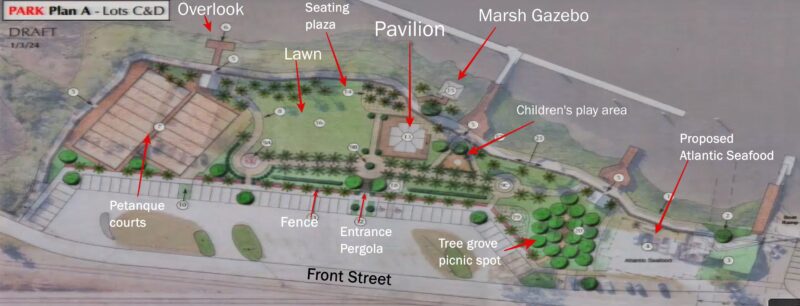
By Mike Lednovich
So far, so good for the latest plan put forward to convert the city’s six acres of unimproved riverfront property into a fully landscaped park with a performance stage, paved walkways, a grassy open space and lots of trees.
The city commission, meeting Tuesday as the executive board of the Community Redevelopment Agency Advisory Board (CRAAB), approved having construction plans drawn that would then be reviewed by the city’s Technical Review Committee.
The 4-1 vote of support by commissioners has been the most significant step in realizing a waterfront park since 2012, when the city commission approved plans and actually borrowed construction money for the project. The 2012 effort was derailed the following year when newly elected commissioners did an about-face on the park and returned the money to the bank.
“This is not the final approval. What this is, is the commission giving the thumbs up. We love this concept. We’re saying let’s get the go-ahead on this,” said Mayor Bradley Bean. “We still need to get a review from the HDC (Historic District Council) and the Technical Council. This is something that can be easily done.”
In his four years on the commission, Bean has been steadfast in his support of efforts to have a waterfront park put in place.
“We’re taking a place in our community that’s been neglected and with just a little bit of money, a small investment, we can turn it into something people will use for many different reasons,” he added. “Finally, I’ll end with, it’s time, it’s just time (to do this).”
Two other projects are in the works on property adjacent to the park location. First is the demolition of the current Atlantic Seafood building in order to finish the flood protection wall north to the marina boat ramp. The other is a new replacement Atlantic Seafood building to be located on a parcel next to the existing building.
Vice Mayor David Sturges cast a ‘no’ vote on the motion to proceed with the plan.
“I do think we need to do it, I don’t think it has to be done today,” Sturges said. “We could wait until some other things are done. I’m just not a big fan of petanque courts being out there, whether it’s 50 or 100 people that use it.”
But then Sturges contradicted himself, saying he fully supported the annual international Petanque Tournament held on the 16 petanque courts on the site. The city also converts the gravel parking lot into more courts to accommodate what is the largest petanque tournament in the U.S.
CRAAB Chair Lisa Finkelstein told commissioners that the park could be funded using parks and recreation impact fees. That fund currently has a little more than $4 million in its account.
Commissioner Darron Ayscue praised the simplicity of the park’s design.
“It’s very basic, and it’s very easy to switch out things whether it’s petanque courts or whether it’s a circle walk-through,” Ayscue said. “There’s a lot in this plan that works really well, and if it didn’t (work) we could change it in a matter of one or two votes.”
The primary opposition voiced to the park plan was the existing petanque courts.
Michael Sharpe, during public comment, told commissioners only about 0.35 percent of the city residents use the petanque courts.
“The rest of us taxpayers don’t want to fund petanque courts on our waterfront,” Sharpe said. “All of you must know that this is not in our city’s best interest.”
Sharpe said the parking demands of new projects need to be addressed first.
“Let’s see what happens down there (the waterfront). There’s a lot of things taking place. There’s more going on there, and we want to throw (the park) at this.”
Commissioner Chip Ross said the next steps once construction plans are completed is to have the Technical Review Committee review the drawings and then have the city commission approve the use of impact fees to fund the project.
